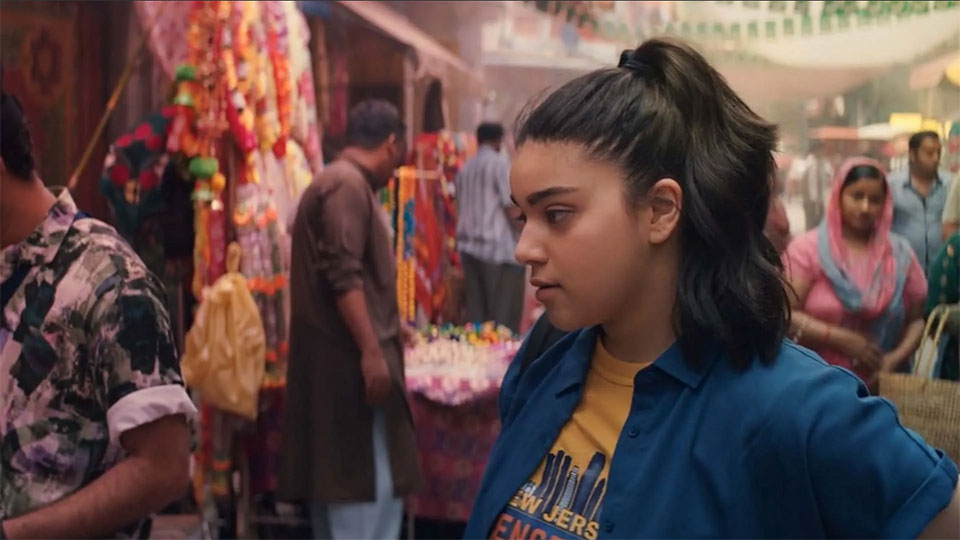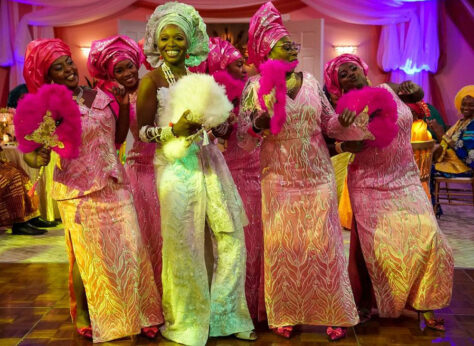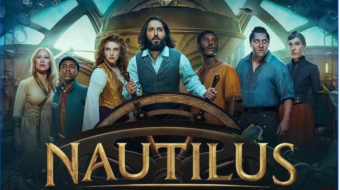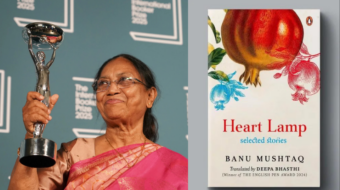
There are two groups that the recently concluded Disney+ Series Ms. Marvel may have turned off initially but who should follow this groundbreaking series through to its end to experience its transformational and liberatory potential. The first are the usual Marvel fans who see themselves as caught up in the studio’s “commodified seriality” where every series and film relates to every other and who search for “Easter eggs” which identify these affinities and hint at future projects. They will find this series adds a social dimension to the studio’s offerings correcting past semi-colonial productions (i.e., the much-praised Moon Knight) and illustrating how the “Phase 4” Multiverse can be used not just to hook fans through its interminable complexity (Loki) but also through its ability to tell historical truths—in this case, its revelation of the sadness and horror of the British partition of India, marking Hindus and Muslims as enemies in the creation of Pakistan.
The second group are those who believe that nothing good can ever come of the Marvel Universe when in fact there are projects which point the way toward a better world, such as the Afro-Futurism on display in the kingdom of Wakanda in Black Panther. To that we can add Episode 6 of Ms. Marvel, and the weight of the series itself, which is, in slightly veiled form, the history of American persecution of Muslim peoples and neighborhoods post 9/11 and a recounting of the resilience of those communities in fighting back.
Ms. Marvel starts out as just the usual plug for the Marvel Universe with the American teen Kamala Kahn (a charmingly authentic Iman Vellani) part of a lovingly detailed South Asian Muslim community in Jersey City, who adores Carol Danvers’s Captain Marvel superhero and sneaks away from her controlling Indian/Pakistani parents to go to “Avengers Con.” Here her powers are revealed, flowing from a bangle, a magic bracelet, a gift from her grandmother in Pakistan. On a rooftop afterward, she despairs of ever becoming like her idol because “it’s not…brown girls from Jersey City who save the world,” pointing up not only the dominance of whiteness but also of the rich, such as the defense industry entrepreneur Tony Stark (Iron Man), in the superhero genre.
Elsewhere, Kamala’s best female friend Nakia (Yasmeen Fletcher), runs for and is elected to the board of the local mosque. Her traditional Muslim attire is complicated by her contemporary feminist approach to power sharing and her up-to-date grasp of popular culture. The character, in the words of one of the series creators, “breaks a lot of the stereotypes for hijab girls.”
The opening episodes are replete with the sights and sounds of Muslim culture, both traditional and Americanized, as Kamala with her new superpowers saves a boy from falling at an Eid al-Adha celebration (the Muslim holy day of sacrifice and giving to the poor). And Kamala’s brother’s wedding features a fabulous Bollywood dance number. Kamala herself dances around the house, after meeting a dashing Muslim boy, to Ronnie Spector’s Be My Baby.
The series, written, directed, and produced by an ensemble of American and British Asian, and South Asian artists, led by series creator Bisha K. Ali, then takes a dramatic turn at the mid-point as Kamala and her family are called to Karachi by her grandmother to explain her powers. A mysterious 1940s train appears to Kamala and seems to be a part of the typical Marvel time-warp, multidimensional world. The series at first highlights wealthy upper-class Pakistan and takes on the look of Crazy Rich Asians, but a more ground-level market scene and the introduction of a more working-class group, the Red Daggers, who battle the supervillains, the Clandestines, who appear from another dimension, rights this path. The series is awash in the sights and smells of the marketplace, although it then indulges in a James Bond-type colonial ravaging of the streets in a superhero/supervillain contest that is oblivious to its actual occupants.

More and more American series are now venturing into the developing world with mixed or often negative results and without the grounding of the Pakistani family in Ms. Marvel. The worst was probably Marvel’s preceding series Moon Knight, which features the absurd colonial sight of the turbaned villain Ethan Hawke, right out of an utterly racist classical Hollywood film, commandeering Egyptians to unearth a pyramid treasure. Along with that goes the schizoid flashback of the otherwise spectacularly written The Old Man which lionizes a CIA vigilante killer allied with the most regressive elements of Afghani society, the Mujahideen. Much better was the admiring of the Lagos market and the jubilation of the wedding ceremony of the Detroit sock merchant and the Nigerian nurse in the beginning of this season’s Bob Hearts Abishola.
Ms. Marvel, though, goes each of those one better and points to the way the Marvel Multiverse might acquire meaning other than simply as a time-shifting graveyard of past Marvel products as the windup of the current Spiderman trilogy Spider-Man: No Way Home brought back the other two Spidermen from the previous trilogies as well as their foes in what amounted to a nine-film plug for the Marvel catalog.
In episode five, of six, Kamala is returned using the bangle to the moment of the partition as, perched atop a train, she watches a momentous scene of people fleeing with all their possessions and attempting to clamber aboard the last way out of India for Pakistan. The episode opens with a short documentary explaining the harshness of the British decision to divide the two countries, then flashes back to a story of love between a Muslim woman and a backer of Indian independence that will finish in a tragically tearful moment that Kamala tries to right as the train is departing. And when was the last time you cried at a Marvel film or television show? Never, I reckon.
The superhero/villain plot is also about a partition and echoes the more social-historical plot as the Clandestines have been separated from their dimension and home in Noor and are trying to return to it, an event which would destroy the earth. This is standard Marvel stuff, but the point here is that the series doesn’t become obsessed with it. This plot in fact ends in Episode 5. Instead, the subject of the last episode, where Kamala and her family return to Jersey City, is the attempt to wreak havoc on the community by a government organization which is attempting to capture Kamala.
Called the Department of Damage Control (DODC), the agency is clearly a stand-in for the Department of Homeland Security, and its overzealous female persecutor may be a stand-in Hillary Clinton who boasted about destroying the Muslim country of Libya. The agents, in a SWAT squad, violate the mosque, which Nakia explains is under surveillance even by “The Department of Sanitation.”
Over 763 attacks on mosques have been reported since 9/11 as, just after that attack, hate crimes on Muslims rose, according to the FBI, 1617 percent. These attacks were given new life in 2016 by Donald Trump’s statement that “I think Islam hates us.” And in fact, the attacks have perhaps only receded as the “War on Terror” gives way to great power conflict between Russia and especially China and consequently as Asian hate crimes peak.
In her battle against the U.S. forces of order, Kamala is given her costume, a big moment in any superhero origin story, sewn by her mother, who then acknowledges her daughter’s independence in a way that heals a rift in the mother-daughter relationship. The costume is ablaze with color, reflecting the splendor of Muslim female fashion, and much more authentic and bounteous than the fake Captain Marvel costume she had worn at the opening. Her father later explains to her that her name Kamala in Urdu, the family’s mother tongue, means “marvel,” in a way that makes her something more than just a franchise namesake.
Kamala and her cohorts, who form a kind of Nancy Drew or In The Dark group, though far less cynical than those outfits, defeat the SWAT squad through their knowledge of their surroundings as the troopers with their sonic boomers invade and are foiled in the teens’ high school. Kamala defeats the legions of federal agents, with the community, and even the local police, cheering her on. Finally, however, she is trapped and about to be captured when the entire community comes together to save her and allows her to escape.
This is a truly remarkable series and shows how the various “verses,” Facebook’s Meta- and Marvel’s Multi-, can be a space for an examination of social, cultural, and political fault lines rather than simply a commercial paradise used for advertising and marketing.
The credits of the series employ a form of splendorous animation over documentary shots of Jersey City and Karachi. In the final episode these credits, in true Marvel fashion, are followed by a short sequence which hints at how Ms. Marvel, Kamala Khan, will be integrated into the Marvel Universe. It is hoped that that integration might involve a change in that universe so that it becomes something other than a surging, churning machine and so that Kamala Khan retains her links to her heritage and community and in so doing helps transform something that has become dry and aridly predictable into something fertile.










